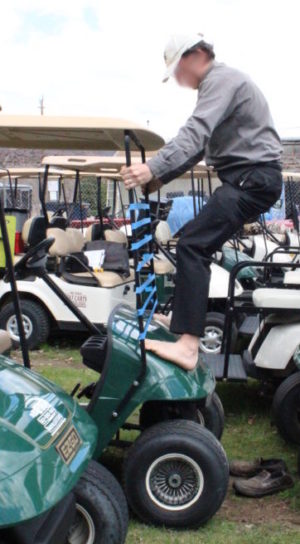One evening at a country club in Oklahoma, a group of six men were using a four passenger golf car to travel around the course and make preparations for an upcoming tournament. During this informal round of putting, one of the men (the plaintiff) fell and sustained a posterior skull fracture with internal bleeding that left him with a traumatic brain injury and no memory of the event. Afterwards, it was discovered that his T-shirt had significant discoloration and tearing along the lower back and the right shoulder and blood evidence was found on the inside of his blue jeans near his shins.

During the civil court discovery process, the eyewitnesses gave wildly different versions of the event. The defendant driver, for example, failed to correctly report the total number of people present during the event and he and his friend testified that the plaintiff fell unbeknownst to them for some unknown reason while everyone else was golfing. However, two other men who were later revealed to have been present during the incident told a very different story. According to them, the golf car was not big enough to accommodate everyone and so the plaintiff was, with the approval of the driver, riding on the front cowl/hood of the vehicle while facing the rear of the car and holding on to the roof supports. Furthermore, they stated that just before the incident the driver abruptly applied the brakes, which caused the plaintiff to fall off the front of the car and strike the back of his head on the concrete car path before the golf car came to rest with the front wheels straddling his legs.

Technology Associates was hired to investigate the accident to determine which version of the incident was supported by the physical evidence and biomechanical evaluation given the wildly conflicting eyewitness reports. Our investigation included testing of an exemplar golf car, clothed dummy drop and drag testing and biomechanical computer simulations and calculations using a simulation software package known as Articulated Total Body (ATB). The clothed dummy testing showed that the damage marks on the plaintiff’s clothing were consistent with significant sliding on the pavement, which would have resulted from a backward fall involving a significant initial backward horizontal speed, but not from a fall from a normal standing or walking position. In addition, the biomechanical simulations and vehicle stopping distance calculations showed that the rest position of the plaintiff relative to the car described by the independent eyewitnesses and evidenced by the blood evidence on the inside of the plaintiff’s pants was consistent with the fall beginning at the same time as the vehicle brake application and not before it. Taken together, the various investigation methods led to the conclusion that the only eyewitness scenario that was consistent with the head injury and the physical evidence found on the plaintiff’s clothing was that the plaintiff was riding on the hood of the vehicle facing backwards and he fell off and landed on his backside when the driver abruptly applied the brake.
After our engineering report was disclosed and one of our engineers testified in the bench trial, the judge found for the plaintiff and awarded him $17.9 million in damages.